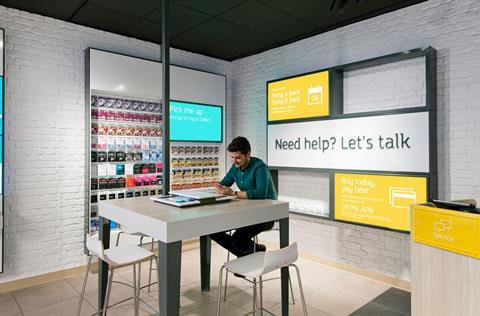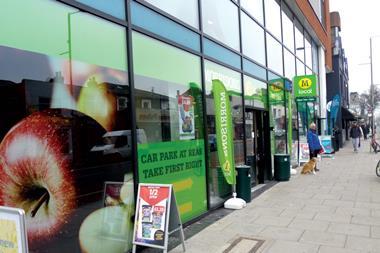As Argos pilots its new generation of digital stores, Mark Faithfull looks at the rise of a hybrid format and the implications for distribution and online fulfilment.

Laminated catalogues, tiny pencils and flimsy slips of paper could become a thing of the past at Argos as the general merchandise retailer becomes the latest high street operator to blur the edges of online and physical trading.
In the run-up to Christmas, the retailer unveiled six new-model digital stores, all with extensive changes to the store exterior, interior and mechanics to improve the customer journey, enable better engagement of customers by staff and speed up transactions.
“The digital concept stores enable us to trial features of what we believe a store should offer in a digital future”
John Walden, Home Retail
Hailed by incoming Home Retail chief executive John Walden as a “test of what might be the store of the future”, the pilot caters for Argos’ new breed of internet-savvy consumers.
At the new digital concept stores in Old Street, Marble Arch, Old Kent Road and Chancery Lane in London, and Colchester and Dunfermline, the idea is to create a stronger connection between how customers shop in store and online.
This is achieved through a host of features including a 60-second ‘Fast Track’ collection service for customers purchasing goods online or via mobile devices; in-store shopping using iPads with expanded shopping applications such as product videos and customer reviews; and a single payment and collection point.
Catalogues have not completely disappeared - they will still be available to collect from staff or as shopping aides in the customer service area - but digital display screens have replaced static sales literature and posters.
The new stores are also testing a ‘hub-and-spoke’ distribution model, whereby the larger ‘hub’ stores stock an expanded range and deliver products in a van to smaller ‘spoke’ stores, providing all stores with either immediate, same-day or next-day access to an expanded range of products.
For Walden, the approach is designed to re-imagine the store, improve product choice and speed of availability, and to create “universal appeal”.
“The new digital concept stores enable us to trial with customers several important features of what we believe a store should offer in a digital future, such as a modern and universally appealing environment, a fast and digitally enabled shopping journey, market-leading fulfilment options and friendly colleagues that provide a human touch,” he says.
The store development goes hand-in-hand with a deal, signed just weeks after the launch of the new format, to distribute for eBay through click-and-collect.
Walden argues that to be convenient to the customer, a retailer needs lots of well-located pick-up points and a large, efficient distribution network - which is where Argos’ 700 store estate comes in.
“We’re increasingly looking at this as a way of providing fulfilment and speeding delivery to the customer”
Andy Murray, Carphone Warehouse
While the eBay agreement is initially a six-month trial across 150 Argos stores and 50 eBay sellers, eBay president Devin Wenig said of the move: “Traditional retail isn’t going away; it is transforming. We’re proud to join Argos on this journey. Its unique store network and operating model is fit for serving customers in a digital future.”
Walden believes that it is only through such an extensive store network that such an approach will work. And even then Argos is not without competitors in this space, notably from the 5,000 strong convenience store network Collect+, which has become the pick-up partner of etail giants including Amazon, Asos, Shop Direct and eBay as well.
Amazon’s lockers are also primarily located in retail outlets, notably Co-op stores and at Land Securities’ One New Change development in the City of London.
The full complement
Argos is among a number of forward-thinking retailers committed to adapting their physical spaces in a bid to enhance their cross-channel offering and improve online fulfilment.
Some retailers are significantly flexing their formats to embrace and adjust to the multichannel scenario. Best known is John Lewis, which last year opened smaller branches in shopping centres in Exeter and York. These stores use technology such as iPads and touch-screens to enable it to offer the same in-store assortment from 60,000 sq ft as is available in the full-line 250,000 sq ft John Lewis stores. Recently the retailer also committed to a multi-format store expansion programme.
In the UK Marks & Spencer opened a flagship technology-based store in Cheshire Oaks, but arguably more influential was its decision to open a 5,000 sq ft ‘e-boutique’ in Kalverstraat in Amsterdam. The store features digital innovations including a ‘virtual rail’, comprising three stacked 46-inch screens and three physical rails, each holding 50 clothing samples, showcasing the latest trends. It sits alongside order points, a range of screens and style advisers equipped with iPads.
M&S executive director, multichannel ecommerce Laura Wade-Gery says the “innovative, aspirational” e-boutique has allowed the retailer to offer its latest fashions from premises with a much smaller footprint and, together with the mobile and online sites, brought a “unique experience to the M&S customer in the Netherlands”.
Like Argos, Carphone Warehouse is overseeing a hub-and-spoke strategy. “We’re increasingly looking at this as a way of providing fulfilment and speeding delivery to the customer,” Andy Murray, head of supply chain and space planning, says of an approach that, ironically, brings with it additional requirements for back-of-house space after many retailers have spent years minimising their ‘unproductive’ non-trading areas.
A super-size solution
While such stores offer a glimpse of the future, some believe widespread alteration of store estates is still a long way off. Sean Gillies, executive director of retail for Savills, points out that such transition is at “an early stage” and says most retailers continue to use the traditional architecture of their estate. “Do these changes mean larger stores? It’s hard to say, although clearly with click-and-collect one of the key considerations is ingress and egress, both at a store level and for shopping centres and out-of-town centres,” he reflects.
Gillies does see potential for more fulfilment through out-of-town and retail park locations, but points out that for the moment most available units are in the 2,500 sq ft to 5,000 sq ft range, meaning retailers are constrained by available supply and also potentially by planning restrictions.
The answer could lie in mega fulfilment centres or XXL warehouses (see box). Typically operating 24 hours a day, seven days a week, these units span about 540,000 sq ft to
1 million sq ft. According to CBRE, take-up of XXL warehouses in Europe was above 43 million sq ft in the 18 months from the beginning of 2012, with the UK, France and Germany dominating.
Amaury Gariel, head of EMEA industrial and logistics at CBRE, says: “We are undoubtedly seeing growth in demand for XXL warehouses arising from supply chain reconfiguration and the consolidation of operations into fewer, larger centralised hubs.”
‘Parcel hubs’ or ‘sortation centres’ are also becoming more widespread. These buildings sort orders by postal/geographical code so that items can be delivered to the appropriate parcel delivery centre for final delivery to the home or collection point.
Jones Lang LaSalle points out that this may encourage some retailers to set up their own networks of local depots - either to cross-dock items shipped from larger e-fulfilment centres or to ship certain fast-moving products direct to customers. In this emerging model, these facilities will be mainly based around the major population centres where online sales densities are highest. In the UK, Amazon wants to open 20 smaller distribution facilities around major urban areas.
While pure-play retailers have set up dedicated distribution facilities to fulfil orders, multichannel retailers have a variety of fulfilment options, including picking from their stores, using existing distribution centres, opening dedicated e-fulfilment centres or using a combination depending on the density of customer orders. This depth of choice demonstrates just how vital physical locations will remain in the multichannel journey.
Grocery retailers push ahead with dark stores
E-fulfilment centres could completely replace the need for in-store picking in locations where sales densities are particularly high, according to a report from Jones Lang LaSalle. “Multichannel retailers will switch from picking orders from stores to picking from e-fulfilment centres in areas where sales densities justify this. However, stores will remain important in areas where drop densities are relatively low,” the report says.
A number of the UK’s grocery retailers are leading the move to dark stores that service only online picking and are closed to customers:
- Sainsbury’s is to open its first dark store in Bromley-By-Bow, east London “within the next few years” to help it meet “growing demand for its online grocery service in London and the Southeast”. When fully operational,the 185,000 sq ft facility will allow Sainsbury’s to serve an additional 20,000 customerseach week.
- Waitrose is to open a second dark store to fulfil online orders in London this year. The depot in Coulsdon, south London will double Waitrose’s capacity to deliver groceries to online shoppers and will dispatch twice as many orders per week as its existing dark store in Acton. It is to open in autumn 2014 and will complement picking online orders from more than 150 stores nationwide and through its Acton warehouse.
- Tesco has four dark stores serving London and the Southeast. It will open a fifth in Crawley early this year and a sixth in Erith, near Dartford, in the next 12 to 15 months. Each new dark store enables Tesco to redesign 10 of its regular supermarkets to make those stores easier for customers to shop and it is looking at other conurbations outside London.


























No comments yet